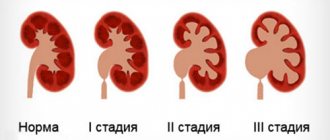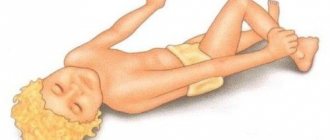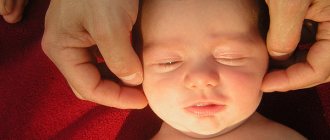What is a crisis?
In short, the newborn crisis in psychology is the very fact of the birth of a child. Such a sharp change in comfortable conditions in the womb to new conditions causes great stress in the baby.
The causes of this crisis are divided into two groups:
- physiological (the child is no longer connected by the umbilical cord to the mother, changes the way he eats, enters the air, feels cold, bright light);
- psychological (the child experiences anxiety and insecurity, because he no longer feels the mother’s warmth with his whole body).
The main characteristic of the neonatal crisis is weight loss in the first days after birth. To this are added the baby’s cries, with which he gives a signal about the dissatisfaction of basic needs, and the manifestations of conditioned reflexes.
According to L. S. Vygotsky, the neonatal crisis lasts from 4 to 6 weeks of a child’s life, until he develops a revival complex. Before this, the baby has not formed a single act of behavior; he sleeps almost all the time.
This means that without the care and attention of a mother or another loved one, the baby will not be able to survive. Such dependence on adults and the inability to express one’s desires provokes further active development of all the child’s systems.
Possible complications
Adults play a huge role in the successful adaptation of the baby to changed conditions. An absolutely defenseless baby cannot withstand changes in the environment (temperature, light, noise) on his own; without the care of his mother, he will simply die.
At the same time, simple care (feeding, changing clothes, bathing) is not enough for the child. If the mother does not establish emotional contact with him, then this period will take a longer time and can provoke developmental delays.
According to L. S. Vygotsky, it is the newborn crisis that forms a child’s basic trust in the world and confidence in his own safety. For this stage to be successful, the newborn must feel the calmness and love of a loved one, understand that he is always there and responds to his cry.
Through the mother, the child develops his entire attitude towards the world, which will have an impact on adult life. When trust in her is formed, then:
- the world is perceived as reliable and stable, there are people in it who will understand and provide support and care;
- all difficulties in life, problems and age-related crises are endured less traumatically and more persistently.
The main difficulty is that a young mother cannot always give her child everything he needs during this period. Sometimes a newborn crisis coincides with postpartum depression of the mother. The birth of a baby provokes a personal crisis in her: the mother is not always confident in her abilities, that she knows how to act correctly in any situation, she cannot accept that she no longer belongs to herself and does not manage her time as she wants.
To prevent this from happening, there must be someone close or experienced person next to the mother and child. Anyone who can provide support: convince the woman that no one understands the baby better than her, will allow her to enjoy contact with him without worrying about household chores, and will simply be ready to help.
1.3. Research methods in developmental psychology
The set of research methods used in developmental psychology consists of several blocks of techniques borrowed from general, differential and social psychology.
Methods for studying cognitive processes and a child’s personality are taken from general psychology. They are adapted to the child's age and explore perception, attention, memory, imagination, thinking and speech. Using these methods, it is possible to obtain information about the age-related characteristics of children’s cognitive processes and the transformations of these processes as the child grows up, i.e., about the specifics of the transition from one age group to another.
Methods for studying individual and age differences in children are borrowed from differential psychology. The so-called “twin method”, which studies the similarities and differences between homozygous and heterozygous twins, is very popular. Based on the data obtained, conclusions are drawn about the organic (genotypic) and environmental conditioning of the child’s psyche and behavior.
Social psychology has provided developmental psychology with methods that allow it to study interpersonal relationships in various children's groups, as well as relationships between children and adults. These methods include: observation, survey, conversation, experiment, cross-sectional method, testing, questioning, analysis of activity products. All these methods are also adapted to the age of the child. Let's look at them in more detail.
Observation
- the main method when working with children (especially preschool age), since tests, experiments, surveys are difficult to study children's behavior.
It is necessary to begin observation by setting a goal, drawing up an observation program, and developing an action plan
. The purpose of observation is to determine why it is being carried out and what results can be expected as a result.
In order to obtain reliable results, monitoring must be carried out regularly. This is due to the fact that children grow very quickly and the changes that occur in the child’s behavior and psyche are also fleeting. For example, a baby's behavior changes before our eyes, so by missing one month, the researcher is deprived of the opportunity to obtain valuable data about his development during this period.
The younger the child, the shorter the interval between observations should be. During the period from birth to 2–3 months, the child should be monitored daily; at the age of 2–3 months to 1 year – weekly; from 1 year to 3 years – monthly; from 3 to 6–7 years – once every six months; at primary school age - once a year, etc.
The observation method when working with children is more effective than others, on the one hand, because they behave more directly and do not play social roles characteristic of adults. On the other hand, children (especially preschoolers) do not have sufficiently stable attention and can often be distracted from the task at hand. Therefore, whenever possible, covert observation should be carried out so that the children do not see the observer.
Survey
can be oral and written. When using this method, the following difficulties may arise. Children understand the question asked to them in their own way, that is, they put a different meaning into it than an adult. This happens because the system of concepts in children is significantly different from the one used by adults. This phenomenon is also observed in adolescents. Therefore, before getting an answer to the question asked, you need to make sure that the child understands it correctly by explaining and discussing inaccuracies, and only after that interpret the answers received.
Experiment
is one of the most reliable methods of obtaining information about the behavior and psychology of a child. The essence of the experiment is that in the process of research, mental processes of interest to the researcher are evoked in the child and conditions are created that are necessary and sufficient for the manifestation of these processes.
A child, entering an experimental play situation, behaves directly, responding emotionally to the proposed situations, and does not play any social roles. This makes it possible to obtain its true reactions to the influencing stimuli. The results are most reliable if the experiment is carried out in the form of a game. At the same time, it is important that the child’s immediate interests and needs are expressed in the game, otherwise he will not be able to fully demonstrate his intellectual abilities and necessary psychological qualities. In addition, when participating in an experiment, a child acts momentarily and spontaneously, so throughout the entire experiment it is necessary to maintain his interest in the event.
Slices
- another research method in developmental psychology. They are divided into transverse and longitudinal (longitudinal).
The essence of the cross-sectional method is that in a group of children (a class, several classes, children of different ages, but studying in the same program), some parameter (for example, intellectual level) is studied using certain techniques. The advantage of this method is that in a short time it is possible to obtain statistical data on age-related differences in mental processes, to establish how age, gender or other factor influences the main trends of mental development. The disadvantage of the method is that when studying children of different ages, it is impossible to obtain information about the development process itself, its nature and driving forces.
When using the method of longitudinal (longitudinal) sections, the development of a group of the same children is traced over a long period of time. This method allows us to establish qualitative changes in the development of mental processes and the child’s personality and identify the causes of these changes, as well as study development trends and minor changes that cannot be covered by cross-sections. The disadvantage of the method is that the results obtained are based on studying the behavior of a small group of children, so it seems incorrect to extend such data to a large number of children.
Testing
allows you to identify the level of intellectual abilities and personal qualities of the child. It is necessary to maintain children's interest in this method in ways that are attractive to them, for example, encouragement or some kind of reward. When testing children, the same tests are used as for adults, but adapted for each age, for example, the children's version of the Cattell test[1], Wechsler test[2], etc.
Conversation
- this is obtaining information about the child through direct communication with him: the child is asked targeted questions and expected answers to them. This method is empirical. An important condition for the effectiveness of a conversation is a favorable atmosphere, goodwill, and tact. Questions must be prepared in advance and the answers recorded, if possible without attracting the attention of the subject.
Questioning
is a method of obtaining information about a person based on his answers to pre-prepared questions. Questionnaires can be oral, written, individual or group.
Analysis of activity products
is a method of studying a person through the analysis of the products of his activity: drawings, blueprints, musical works, essays, school notebooks, personal diaries, etc. Thanks to this method, you can obtain information about the child’s inner world, his attitude to the surrounding reality and people, about peculiarities of his perception and other aspects of the psyche. This method is based on the principle of the unity of consciousness and activity, according to which the child’s psyche is not only formed, but also manifested in activity. By drawing or creating something, a child provides researchers with the opportunity to reveal aspects of his psyche that would be difficult to find out using other methods. Based on the drawings, you can study cognitive processes (sensations, imagination, perception, thinking), creative abilities, personal manifestations, and children’s attitude towards people around them.
How to organize the adaptation of a baby
To avoid all possible complications and to develop a newborn’s basic trust in the world, parents should know how to behave during a newborn crisis:
- monitor the temperature in the room that is comfortable for the baby;
- feed the baby on demand as much as he needs;
- establish communication: talk kindly to the baby, address him by name, accompany all procedures with communication;
- monitor the microclimate in the family: be calm, attentive and caring parents - the child picks up on the emotional state of adults;
- Carry out light exercises and massage for the baby;
- for comfortable bathing, it is recommended to use a diaper or a soft towel: a baby wrapped in it, remembering a similar state in the mother’s stomach, will perceive the water less anxiously;
- do not overload the places where the baby spends time with bright colors and details - this can greatly irritate his nervous system (it is better to stick to light pastel colors);
- try to create a daily routine for the child and monitor its compliance.
There are many views on the development and upbringing of children, which sometimes contradict each other. Young parents don't always understand what advice to take with skepticism.
In order not to harm your baby in times of crisis, you need to know exactly what not to do.
- You should not start the active development of the child from the first days: surround him with many bright toys, pictures, songs, etc. This can oversaturate the baby with emotions and impressions and lead to anxiety. After all, a very important moment of development at this time is the emergence of auditory and visual concentration. He must learn to catch sounds and objects, but it is still difficult for a baby to react to a large number of them.
- Don't leave your baby alone when he cries, even if you are sure you have met all his needs. The baby will not scream and cry for no reason; perhaps he just needs parental attention at this moment. The situation when he lies and gets very upset without getting a reaction makes him feel very anxious and lonely. This violates his basic trust in the world.
Revitalization complex
The main result of the newborn crisis is the revival complex. This is a set of baby’s reactions to external stimuli. It is a combination of the following actions:
- reaction of freezing and visual concentration on the object of attention in the first seconds of communication;
- lively movements of the legs and arms, arching of the back;
- a smile as a response to an adult’s speech;
- vocalizations (loud cries and prolonged hums) during communication.
With the totality of these reactions, the child takes the initiative to communicate with an adult.
It is important to know!
The child's revival complex begins to manifest itself towards the end of the first month of life. It becomes more pronounced at the age of two months. Scientific studies have shown that it appears earlier in those children whose parents not only satisfy the child’s vital needs, but also communicate with them.
With their attention, love and care, adults stimulate the formation of new emotions, needs for cognition and communication in the baby. With a lack of communication and attention from parents, the revival complex may linger or deviations in its expression may be observed.
Mother-child dyad
With the physical separation of mother and child, their psychological unity does not end. In psychology, this phenomenon is called the “mother-child” dyad; this period can also be called the fourth trimester of pregnancy.
Many mothers notice with interest that they really create some kind of elusive connection with their baby. For example, they distinguish different shades of crying and whims, when each has its own reason, or wake up in the middle of the night exactly a couple of seconds before the child wakes up, as if someone specially woke them up.
While the baby is helpless, he perceives and learns everything through a significant adult: he satisfies his needs, gets to know himself and his emotions, and forms an attitude towards the world around him. If he has good contact with his mother: she carries him in her arms, treats him kindly, smiles and strokes him, then the child picks up the signal “Everything is fine.” And if he is left with negative emotions from communication, then the attitude is formed: “The world is not safe, this is very bad.” If this situation is repeated time after time, then the “I’m bad” attitude goes with the child and further into adulthood.
The “mother-child” dyad weakens by 3 months of the baby’s life: he has already adapted to new living conditions, realized that his mother will always come to the rescue, and has learned some independent actions. By this time, the psyche had also undergone changes: the child began to sleep more soundly at night, ask for food less often, and better control his movements.
We can talk about complete separation of mother and baby by 10-14 months of his life. Now he is completely ready to independently explore the environment, express emotions and convey demands.
Parents who know about the phenomenon of the “mother-child” dyad not only help the baby go through the newborn crisis more smoothly, but also adapt and perceive this period more calmly.
Features of a newborn
In the first days of his life, the child has some characteristics:
- the child spends most of the time sleeping (about 80% of the time);
- the remaining 20% he is awake, but at the same time is in a half-asleep state;
- the baby moves his arms and legs in a chaotic manner (therefore he can scratch himself and wake himself up), gradually the movements become more conscious;
- all behavior of an infant consists of unconditioned reflexes (the revival complex is the first act of behavior).
The most important unconditioned reflexes that gradually disappear are:
- Moro reflex (when a child is raised and lowered, his arms move apart and his fingers spread out);
- stepping reflex (if you place the baby’s feet on a hard surface and slightly tilt them forward, he will begin to step with his legs as if walking);
- grasping reflex (any object that an adult places in the baby’s palm turns out to be tightly squeezed);
- Babkin reflex (pressure on the baby’s palm and forearm forces him to open his mouth and turn towards the stimulus);
- Babinski reflex (stroking the foot from the heel to the toes causes all the toes to bend);
- the “breast search” reflex (touching a child’s cheek provokes the baby to turn towards the stimulus and open his mouth);
- sucking reflex (the child begins to suck on an object placed in the mouth);
- swimming reflex (once the baby is in the water with its stomach down, the baby makes swimming movements).
End of the newborn stage
The most important stage in the development of a baby during this period is the emergence of auditory and visual concentration. By 2-3 weeks of life, the child reacts to sounds: he freezes when he hears a loud sound. A little later, it begins to react to the human voice: it not only freezes, but also turns its head towards the source of the sound. From the 3rd week, the baby develops visual concentration: he freezes and fixes his gaze on an object that comes into his field of vision. First of all, he keeps his attention on the face of a loved one.
It is these phenomena that are considered the physiological criterion for the completion of the neonatal crisis. In addition, by this time the baby should have regained the weight it was born with.
From a psychological point of view, the neonatal crisis ends when a revitalization complex appears, which is of great importance. It means the beginning of the need for communication and is manifested by the following actions:
- freezing and visual concentration on the object of attention at the beginning of communication;
- animated movements of arms and legs, arching of the back;
- smiling in response to the speaker's speech;
- vocalization in response (loud screams and prolonged hums).
The newborn period ends after 4-6 weeks, giving way to a new stage - infancy.
Newborn crisis
The first period in a person’s life is the newborn (from birth to one or two months). This is the real and very first crisis, a turning point in the life of a child, the meaning of which is the transition from a biological to a social type of development. This is a genuine leap in development, accompanied by a sharp change in living conditions: cold (in the absence of a thermoregulation system), bright light, an air environment that requires a different type of breathing, the action of gravity, a change in the type of nutrition. The difficulty of adapting to a new developmental situation is evidenced by the child’s loss of initial weight during the first days. The medical criterion for the end of the neonatal crisis is usually associated with the moment when the child, after losing weight, regains the original weight with which he was born (approximately 7-1 days after birth). A newborn is completely helpless, he does not have a single established form of behavior, he cannot satisfy a single need on his own, he is completely dependent on an adult.
From the point of view of L.S. Vygotsky, newbornness is an intermediate period between intra- and extrauterine development: the child is physically separated from the mother, but is connected to her physiologically.
The transitional, mixed nature of the development of the newborn is evidenced by:
- the child’s nutrition - he feeds on the product of the mother’s body, although he must “get it” on his own - suck;
- insufficient differentiation of sleep and wakefulness - the child spends 80% of his time sleeping, but his sleep is restless, intermittent and superficial; short periods of sleep alternate with islands of wakefulness; most of the time he is in a state of drowsiness;
- fetal position - the child is in this intrauterine position during sleep and wakefulness;
- motor features - many reflexes of a newborn are atavistic, disappearing after a few months;
- prematurity or postmaturity (birth of a child after 280 days ± 40 days) does not significantly affect its development.
L.S. Vygotsky speaks of the “rudimentary state of the mental life of a newborn,” which represents undifferentiated, undifferentiated experiences (a fusion of affect, drive, sensation); the child does not separate himself, his experiences from the world around him, does not distinguish people from physical objects, perceives the situation as a whole, highlighting the sensory tone of what is happening rather than the objective elements of the surrounding world. The central new formation of this period is the formation of the individual mental life of the newborn.
Newborns have been shown to have the ability to imitate, for example, they stick out their tongues and open their mouths in response to appropriate behavior from the mother.
Sensory abilities of newborns. Compared to adult standards, the vision of a newborn is very poor: they have a much lower accuracy of spatial detail, the movements of a newborn’s eyes have a fixed focal length, i.e. only objects located at a distance of approximately 21 cm from his eyes will be perceived in focus, distant objects have very unclear outlines, and the function of controlling the convergence of the eyes is poorly developed.
Did not you find what you were looking for?
Teachers rush to help
Diploma
Tests
Coursework
Abstracts
Newborns are able to perceive their surroundings. They clearly prefer looking at complex patterns and are particularly attracted to the edges and outlines of objects. Newborns are also exceptionally receptive to the human face: they begin to recognize their mother's face very early. A study by J. Walton and T. Bauer showed that just seven hours after birth, babies prefer to look at a color image of their mother on a computer screen rather than at a stranger's face. According to some researchers, it is likely that during the first hours after birth there is a sensitive period when the newborn is awake and shows a special willingness to capture the individual facial features of its mother.
The auditory system of newborns is quite well developed. Newborns are able to respond to a wide range of sounds. However, they prefer voices in the female range to voices in the male range. Newborns are especially sensitive to the sounds of speech and the human voice: they prefer a song performed by a female voice to the same melody played on a musical instrument. Modern research shows that newborns are able to distinguish their mother’s voice from the voices of other women, which means that the parameters of the mother’s voice become familiar to the baby even in utero. From birth, the visual and auditory systems function in close relationship and coordination with each other. Newborns are also capable of localizing the source of sound: already in the first days of life they turn their eyes in the direction of the sound. The following experiment was conducted: a researcher shook two rattles on either side of a newborn infant, with only one rattle producing sounds. Newborns preferred to look in the direction of the sounding rattle.
Tactile sensations are well developed in newborns. They react to cold, warmth, touch, pain.
The organs of taste and smell also function from birth. Newborns show different reactions to sour (facial reaction - “indignation”) and sweet (expressing pleasure). Newborns show the same facial expression of disgust or pleasure when they smell unpleasant (rotten egg) or pleasant smells (milk, honey, chocolate). From the age of six days, a newborn is able to recognize the smell of breast milk and distinguish it from the smell of another woman.
Important events in the mental life of a newborn are the emergence of auditory and visual concentration. Auditory concentration appears in the second or third week and is expressed in the fact that a sharp sound (and later, in the third or fourth week, a person’s voice) causes a cessation of movements, the child freezes and becomes silent. Visual concentration, which occurs in the third to fifth week, also manifests itself externally: the child freezes and fixes his gaze on a bright object. On this basis, by the end of the first month of life, the first conditioned reflexes appear. For example, in learning experiments, newborns were taught to turn their heads to the left at the sound of a bell and to the right at the sound of a bell, reinforcing each success with a bottle of milk. The appearance of visual and auditory concentration, the possibility of forming conditioned reflexes to individual stimuli (approximately 14-21 days) serve as a physiological criterion for the end of the newborn.
By the fourth or fifth week, the baby begins to smile in response to the image of a human face and voice, usually the mother's face and voice. Until the third week, others fail to catch the child’s gaze; he seems absorbed in himself. By the third week, the first eye contact occurs: the baby focuses on the adult's face for several seconds. Following this, usually after one to two weeks, the first smile appears. A smile is the first social reaction of a child, marking the beginning of his own mental life, as a moment of differentiation, a kind of isolation, and at the same time as the beginning of the formation of a “child-adult” connection, the formation of a child’s need for communication. The first social smile represents a psychological criterion for the end of the neonatal crisis, the beginning of a new period - infancy.










